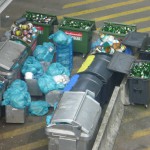Now the EGU2011 in Vienna is over. Thousands of scientists have attended the meeting and more than 13,000 abstratcs were presented. Approx. 20,000 portions of Gulasz and 100,000 Wiener Schnitzels were served, hektoliters of wine and beer went down the throats of thirsty scientists. Some people say the EGU contributes with 10% to the income of Vienna’s bartenders. Several contributions dealt with paleoseismology, paleoseismicity, archeoseismology and paleotsunamis especially on Monday and Friday.
The Aachen work group has contributed several abstracts:
Klaus Reicherter and Thomas Wiatr questioned whether post-glacial fault scarps really are post-glacial or not. (Abstract)
Nadine Hoffmann and Klaus Reicherter reported about the seismogenic landscape of Lake Ohrid, Macedonia. (Abstract)
Thomas Wiatr et al. presented LiDAR investigations from bedrock fault scarps in Crete, Greece. (Abstract)
The active tectonical setting of the Tangra Yum Co Basin in central Tibet was described by Klaus Reicherter et al. (Abstract)
I presented some new data from an active fault in the Lower Rhine Embayment, Germany. We did a geophysical survey (GPR and Geolelectrics) and mapping at the Rurrand Fault close to Düren between Aachen and Cologne and tried to find out whether it is responsible for the 1755-1756 Düren earthquake series. Jonas Winandy will hopefully answer that question in his Diploma thesis. (Abstract)
Here’s a selection of more interesting talks:
Esther Hintersberger et al. presented paleoseismological data from the Vienna basin, revealing the strongest earthquake in Central Europe north of the Alps with an estimated magnitude of 7. (Abstract) – UPDATED: If we consider Central Europe not to include the Lower Rhine Embayment. (Thanks to Simon)
Arkin Kurcer and Gokten presented new data from the Tuzgölü Fault Zone,
Central Anatolia, Turkey. (Abstract)
Mw6.7 and 6.4 EQs were revealed by Rita Carmo et al. in trenches on the Azores (S. Miguel Islands), providing new insights in the history of the Altiprado faults. (Abstract)
Mustapha Meghraoui presented an abstract from Matthieu Ferry on recent paleoseismological and archeoseismological observations at the Dead Sea Fault. (Abstract)
Selected Poster contributions:
Cahit Caglar Yalciner et al. studied the use of GPR for finding buried fault scarps in Western Turkey. (Abstract)
Fabrizio Storti et al. presented new data on the “Evidence for Quaternary strong paleo-earthquakes in the epicentral area of the April 6th 2009 l’Aquila” EQ. (Abstract)
Roman Nepop et al. reasoned about “Geological and statistical aspects of seismically triggered landslides”. (Abstract)
Erhan Altunel et al. worked on the paleoseismological record of the East Anatolian Fault Zone. (Abstract)
Mustapha Meghraoui et al. have searched for earthquake evidence at the Syrian part of the Dead Sea Fault. (Abstract)
Louise Bjerrum presented presented thoughts about ground motion modelling data from the Izmit Earthquake in Turkey. (Abstract)
Angela Landgraf found a fault scarp near Rot Front (!) in Kyrgyzstan. (Abstract)
Petra Jamšek and co-authors searched for paleoseismological evidence in Slovenia. (Abstract)
You can find the program of the Earthquake Geology session here.




Stéphane Baize | 2011-04-10|09:06 (UTC)
Unfortunately, the authors of the Allah Bund fault study did not present their results at the “Earthquake Geology” session of R. Caputo and other convenors… Such a pity.
Christoph Grützner | 2011-04-10|12:50 (UTC)
Oh, my fault thanks a lot, I updated the post. Note to myself: Proof-read the posts that I have prepared in advance.